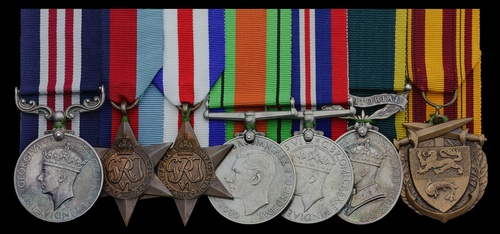
Auction: 20001 - Orders, Decorations and Medals - conducted behind closed doors
Lot: 710
(x) A 1940 'Retreat to Dunkirk' M.M. group of seven awarded to despatch rider Driver H. Hobson, Royal Engineers, who survived two Luftwaffe strafing attacks as he successfully attempted to deliver an important message
Military Medal, G.VI.R. (2091628 Dvr. H. Dobson. R.E.); 1939-45 Star; France and Germany Star; Defence and War Medals 1939-45; Territorial Efficiency Medal, G.VI.R. (2091628 Spr. H. Dobson. M.M. R.E.); Dunkirk Medal 1940, court mounted, very fine and scarce with a citation for the retreat to Dunkirk (7)
M.M. London Gazette 9 July 1940.
The original citation states:
'As despatch rider he regularly and without fail got his messages through regardless of danger and with complete cheerfulness in spite of enemy attacks and lack of sleep. On two occasions his machine crashed due to aerial attack but he nevertheless procured another and got the message through safely. The principal actions involved were the Canal du Nord 18/19 May 1940 and in Bergues on 26 May 1940, but at all times his convoy work and despatch riding were excellent.'
William Hobson served with No. 507 Field Company, Royal Engineers, during the opening exchanges of the Battle of France. As a motorcycle courier it was his role to deliver important orders and messages between Headquarters and military units, which was vital at a time when telecommunications were limited and insecure. First deployed during the Great War by the Royal Engineers Signal Service using 500cc single-cylinder machines and horizontally-opposed twin cylinders, by 1940 the British military had reverted to more powerful Triumph, Norton, BSA, Matchless and Ariel machines, with over 75,000 Norton 16H manufactured during the war alone. Powered by a 14bhp air cooled engine they were capable of a top speed of 68mph and later set a ten-year record for the longest time the War Office produced a single make of motorcycle (British Forces Motorcycles 1925-45, by C. J. Orchard, refers).
On the 18/19 May 1940, No. 507 Field Company, Royal Engineers, were deployed in billets and Queant and charged with blowing seven bridges over the Canal du Nord and two further bridges at Ruyalcourt. Despite having been hindered the four previous days by 'incessant bombing and machine gunning from Bosche aeroplanes' orders were received from Brigadier Kirkup and the bridges were successfully destroyed. The Company War Diary for 19 May 1940 adds:
'The Officers and Other Ranks of this Company have been beyond praise since the Battle started. They have had no bed or good food for days and have worked like demons. Particularly the M.T. under Sergeant Mogie have done very well. My two despatch riders, Driver Hopper and Driver Dobson deserve decoration for their tireless, cheerful and dangerous work. Altogether, 507 Field Company has taken its baptism of fire well and I am glad to say with no casualty up to now, though many narrow squeaks.'
The citation to Driver Hopper adds a little more detail as to the proximity of enemy forces on the ground; at Saint Homblin on 23 May 1940 he set out to find a bridge reconnaissance party and was twice fired on by enemy tanks, each time managing to escape under fire.
By 26 May 1940 the men had reached Les Meures where No. 507 and No. 508 Field Company billeted on a farm. From here they reconnoitred numerous bridges leading into the walled city of Bergues on the Dunkirk perimeter and witnessed a very heavy dive bombing attack which led to casualties in the town. The persistent harassment of British forces as they attempted to reach the English Channel is best told by the son of Lance Corporal Hector Morgan, a reservist caught up in the retreat of the B.E.F.:
'On the way through one of these villages (he couldn't remember which), my father recalls being involved in a cat and mouse game with a Stuka pilot. He and his unit were trying to cross a square in the village when the Stuka dived and strafed the area and they had to hide in house doorways. Just as they thought he'd gone and they had to cross the square, the Stuka would come around again and they would have to dive for cover. This happened several times' (BBC People's War - An Archive of World War Two Memories, refers).
Four days later the main body of the Company left Dunkirk and Bray Dunes beaches for the English Coast, being landed at South Coast ports between Folkestone and Ramsgate.
For a thorough description of events, as detailed by the Company War Diary, please see:
http://70brigade.newmp.org.uk/wiki/507th_Field_Company,_Royal_Engineers_War_Diary_May_1940
Subject to 5% tax on Hammer Price in addition to 20% VAT on Buyer’s Premium. For more information please view Terms and Conditions for Buyers.
Sold for
£2,100
Starting price
£800




